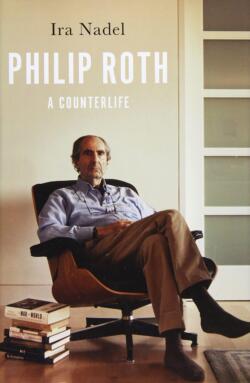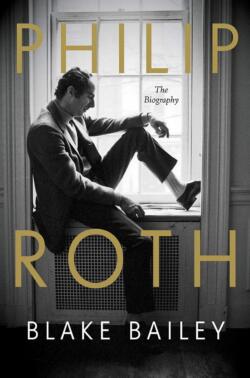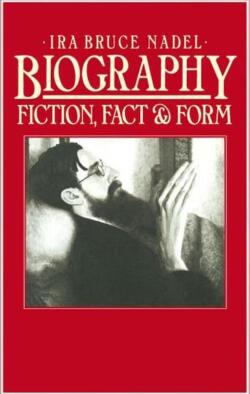1263 Ira Nadel: triumph of the also-ran
Philip Roth, A Counterlife
by Ira Nadel
Oxford and New York: Oxford University Press, 2021
$29.95 (U.S.) / 9780199846108
Reviewed by Grahame Ware
*
 In a recent issue of the London Review of Books, James Wolcott gives us some background on an unusual event in publishing: the simultaneous appearance of two major biographies of an important literary figure, in this instance American novelist Philip Roth (1933-2018). The books are Philip Roth, A Counterlife (reviewed here), by retired UBC professor of English Ira Nadel, and Blake Bailey, Philip Roth: The Biography (New York: W.W. Norton & Company, 2021). Nadel’s book was released on March 10 and Bailey’s on April 6, 2021. They clock in respectively at 576 and 880 pages of text.
In a recent issue of the London Review of Books, James Wolcott gives us some background on an unusual event in publishing: the simultaneous appearance of two major biographies of an important literary figure, in this instance American novelist Philip Roth (1933-2018). The books are Philip Roth, A Counterlife (reviewed here), by retired UBC professor of English Ira Nadel, and Blake Bailey, Philip Roth: The Biography (New York: W.W. Norton & Company, 2021). Nadel’s book was released on March 10 and Bailey’s on April 6, 2021. They clock in respectively at 576 and 880 pages of text.
Of Bailey’s official and authorized biography and Nadel’s upstart offering, Wolcott writes:
It was shaping up to be the publishing event of the year, the first blast of post-pandemica as we emerged from our hobbit holes and combed the cobwebs from our hair: the starship arrival of Blake Bailey’s authorised biography of Philip Roth, Philip Roth: The Biography. The “the”of the subtitle said: accept no substitutes. Another biography of Roth was in the offing, Ira Nadel’s Philip Roth: A Counterlife, a sizeable, solidly researched, intelligently wrought handful whose subtitle, as the journalist Judith Shulevitz noted, seemed to indicate an awareness of its also-ran status against the looming behemoth.[1]

The fly in the ointment is that three weeks after publication, W.W. Norton & Company withdrew the book “following allegations of sexual misconduct [against author Blake Bailey] made in the comments section of a literary blog,” according to the book’s entry in Wikipedia.[2] The irony is that, due to the implosion of the official and authorized biography by the now disgraced Roth-anointed biographer, Nadel’s biography was thrust into the starting role in the Roth biography horse race.
Philip Roth, A Counterlife is a detailed work of some magnitude by Nadel, who had already done some of the heavy lifting for this biography in The Critical Companion to Philip Roth (Facts On File, 2011). And Nadel was well-positioned in other ways to write a worthy biography of Roth. From the beginning of his academic career he has specialized in biography. His interest even led to a book on the craft of biography, Biography: Fiction, Fact & Form (Palgrave Macmillan, 1984). His modus operandi for literary biography dictates that research and not interviews takes priority. During nearly 40 years in the biography harness, Nadel perfected a factual, hands-off approach. In his earlier biographies of James Joyce, Leon Uris, and David Mamet, he refined his fact-based process. Biography: Fiction, Fact & Form had already made him an authority in the scholarly and expanding world of literary biography.

Leaving aside his abundant qualifications, Nadel’s detached and clinical style (so different from Roth) isn’t what this Rothphile was waiting for. Many sections of the biography get into minutiae that might only have academic or voyeur de Roth appeal, such as the alimony payments of his first divorce to Maggie Williams, how appendicitis ran in the family, etc. It’s all there and more.
Nadel’s MO can be seen in a review of his previous book David Mamet: A Life in the Theatre (Palgrave Macmillan, 2008) by Steven Price of UK’s Bangor University: “As a serious scholar who also wants to get out alive, he largely resists any temptation either to speculate or to create a psychobiography to fill in the gaps. Perhaps in consequence, he sometimes looks away when a more shameless writer would reach for the binoculars.” Instead, Price writes, “Nadel has constructed a kind of sociobiography, working from the public record to inscribe his subject within a concentric series of social worlds….”[3]
His approach to Roth’s biography followed a similar approach. Nadel’s tsunami of minutiae suggests that an alternate career as a pathologist might have lain submerged. What emerges is the hybrid biographer-as-pathologist. Surely it must grate on him that the boxes and boxes of private material to which Bailey was given access were not available to him, but it should be noted that Roth left no shortage of raw material for future biographers. He constantly generated, shaped, and publicised his life’s data. No mere 15 minutes of fame for Philip Roth. He lived in a reflexive world where autofiction had become a kind of ultravanity.

What were the social and cultural parallels between Nadel and Roth, their common touchstones? Both are Jewish-American. They grew up within miles of each other in New Jersey, though Nadel is 10 years younger. While Nadel has provided a deep, deep dive into the life of an intriguing and important figure in American literature, it seems to me that their commonalities should have provided more cross-fertilization and inspiration for Nadel’s writing. His book is based on meticulous research, but to me, his deeply detached style drains the book of reading energy. For me, it sometimes felt like a tough read with respites occurring only with the occasional juicy zinger from Roth himself.
Yet there is much of substance here. Nadel argues that while Roth’s mental anguish was fermented in lofty academia, his feet remained firmly stuck in the mundane terra americana of New Jersey. Early in his career, Roth stood apart from what he saw as the ideologically claustrophobic mentality of Zionists who courted him. He famously declared, “I am not a Jewish writer; I am a writer who is Jewish,” and that the passion “in his life [was] to write fiction, not to be a Jew” (p 162). Roth’s New Jersey origins made for fertile ground to lay out his characters and victims, his heroes and his losers — but this wasn’t good enough for the Jewish American literati and intelligentsia, especially social critic Irving Howe. In an especially good chapter, “Travels With Kafka,” Nadel describes the criticism of Roth which was, in essence, “You’re not Jewish enough to criticize us:”
Roth did not grow up in a shetl environment or even the odor of such a past. He was not Polish or Russian born; he lost no one in the Holocaust. He knew nothing of the Mittleuropa culture. He only knew the heartache of Ashkenazi life in Europe second hand, if at all.

Nadel quotes Mark Schechner on Roth’s limitations. “He grew up knowing neither Beethoven nor Sholem Aleichem, neither Scarlatti nor Isaac Babel … neither Raschi nor Trotsky … neither Zionism nor Yiddishism, Talmud nor Torah” (p. 267). In this regard, Roth was certainly no Saul Bellow. According to Bellow’s biographer, James Atlas, “By the time he was four, he could recite whole pages of the book of Genesis in both Yiddish and Hebrew” (p. 492). Nadel outlines how Roth, due to this “vulnerability,” took action in the early seventies and became deeply involved with Czech, and later Hungarian and Polish, writers and artists. He published and edited their works and visited Prague several times and put cash in the hands of the oppressed artists. As Nadel notes, “The experience transformed Roth into America’s most Eurocentric, politically conscious writer” for more than a decade (p. 268). These trips also connected Roth him to Kafka’s family and furthered his deep identification with Kafka and his oeuvre.
*
Nadel’s useful and serviceable book stands while Bailey’s official biography was taken out of print by its publisher on April 28, 2021. I will give the last word to James Wolcott from the London Review of Books:
Unscathed and unmucked is the perfectly fine Life of Roth sitting in plain view minding its own business with no stink attached — Ira Nadel’s. It would be a tasty irony if the also-ran emerged as the upset winner after all. It would be the only light note in this whole misbegotten mishegas [foolishness].[4]
*

Grahame Ware has been a regular contributor to The Ormsby Review since its inception. As well as his book reviews, he has contributed four memoirs, The Sonics at the Grooveyard, On the road with Sir Kenneth, My Private Italy, and My Private Chinatown. He is a member of the SFU-based Canadian Association of Independent Scholars. Grahame lives on Gabriola Island where he is finishing a book on Jim Christie, a Scottish social activist in the nineteenth century Okanagan Valley. He also makes wooden sculpture from forest refugees and driftwood detritus. Editor’s note: Grahame Ware has also reviewed books by Aaron Chapman, John Moore, Ken Smedley, Kerri Sakamoto, Mike Lascelle, Ian Cutler, Michael Barnholden, Jan DeGrass, Jon Steinman, Pirjo Raits, Keith McKellar (Laughing Hand), Dan Jason & Michele Genest, Lou McKee, and Monika Ullmann for The Ormsby Review.
*
The Ormsby Review. More Books. More Reviews. More Often.
Publisher and Editor: Richard Mackie
The Ormsby Review is a journal service for in-depth coverage of B.C. books and authors. The Advisory Board consists of Jean Barman, Wade Davis, Robin Fisher, Cole Harris, Hugh Johnston, Kathy Mezei, Patricia Roy, Maria Tippett, and Graeme Wynn. Scholarly Patron: SFU Graduate Liberal Studies. Honorary Patron: Yosef Wosk. Provincial Government Patron since September 2018: Creative BC
“Only connect.” – E.M. Forster
Endnotes:
[1] https://www.lrb.co.uk/the-paper/v43/n10/james-wolcott/sisyphus-at-the-selectric
[2] https://en.wikipedia.org/wiki/Philip_Roth:_The_Biography
[3] Stephen Price in Style 43:3, p. 444.
[4] https://www.lrb.co.uk/the-paper/v43/n10/james-wolcott/sisyphus-at-the-selectric
3 comments on “1263 Ira Nadel: triumph of the also-ran”
Roth never went to Rutgers he went to Bucknell and University of Chicago
Thanks, Michael. I have deleted the sentence “Both attended Rutgers University,” and I will have a serious word with our copy editor 😉